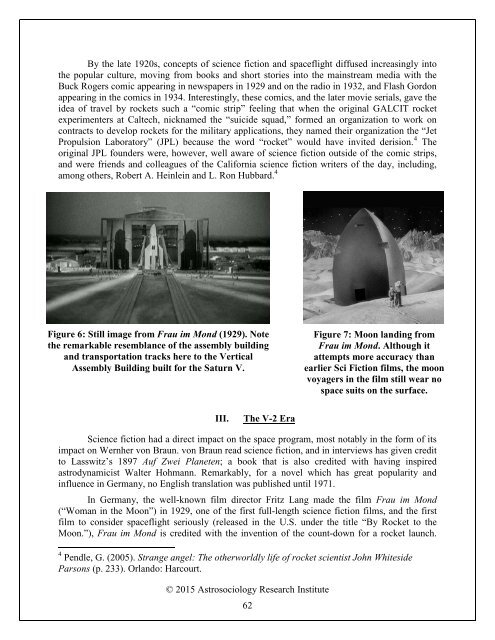THE JOURNAL OF ASTROSOCIOLOGY VOLUME 1
qd9nb3s
qd9nb3s
- No tags were found...
Create successful ePaper yourself
Turn your PDF publications into a flip-book with our unique Google optimized e-Paper software.
By the late 1920s, concepts of science fiction and spaceflight diffused increasingly intothe popular culture, moving from books and short stories into the mainstream media with theBuck Rogers comic appearing in newspapers in 1929 and on the radio in 1932, and Flash Gordonappearing in the comics in 1934. Interestingly, these comics, and the later movie serials, gave theidea of travel by rockets such a “comic strip” feeling that when the original GALCIT rocketexperimenters at Caltech, nicknamed the “suicide squad,” formed an organization to work oncontracts to develop rockets for the military applications, they named their organization the “JetPropulsion Laboratory” (JPL) because the word “rocket” would have invited derision. 4 Theoriginal JPL founders were, however, well aware of science fiction outside of the comic strips,and were friends and colleagues of the California science fiction writers of the day, including,among others, Robert A. Heinlein and L. Ron Hubbard. 4Figure 6: Still image from Frau im Mond (1929). Notethe remarkable resemblance of the assembly buildingand transportation tracks here to the VerticalAssembly Building built for the Saturn V.Figure 7: Moon landing fromFrau im Mond. Although itattempts more accuracy thanearlier Sci Fiction films, the moonvoyagers in the film still wear nospace suits on the surface.III.The V-2 EraScience fiction had a direct impact on the space program, most notably in the form of itsimpact on Wernher von Braun. von Braun read science fiction, and in interviews has given creditto Lasswitz’s 1897 Auf Zwei Planeten; a book that is also credited with having inspiredastrodynamicist Walter Hohmann. Remarkably, for a novel which has great popularity andinfluence in Germany, no English translation was published until 1971.In Germany, the well-known film director Fritz Lang made the film Frau im Mond(“Woman in the Moon”) in 1929, one of the first full-length science fiction films, and the firstfilm to consider spaceflight seriously (released in the U.S. under the title “By Rocket to theMoon.”), Frau im Mond is credited with the invention of the count-down for a rocket launch.4 Pendle, G. (2005). Strange angel: The otherworldly life of rocket scientist John WhitesideParsons (p. 233). Orlando: Harcourt.© 2015 Astrosociology Research Institute62


